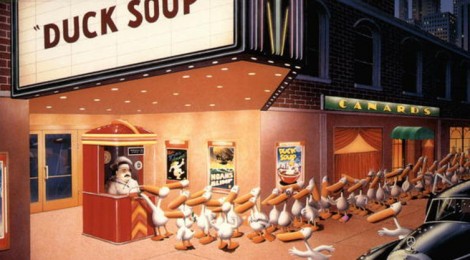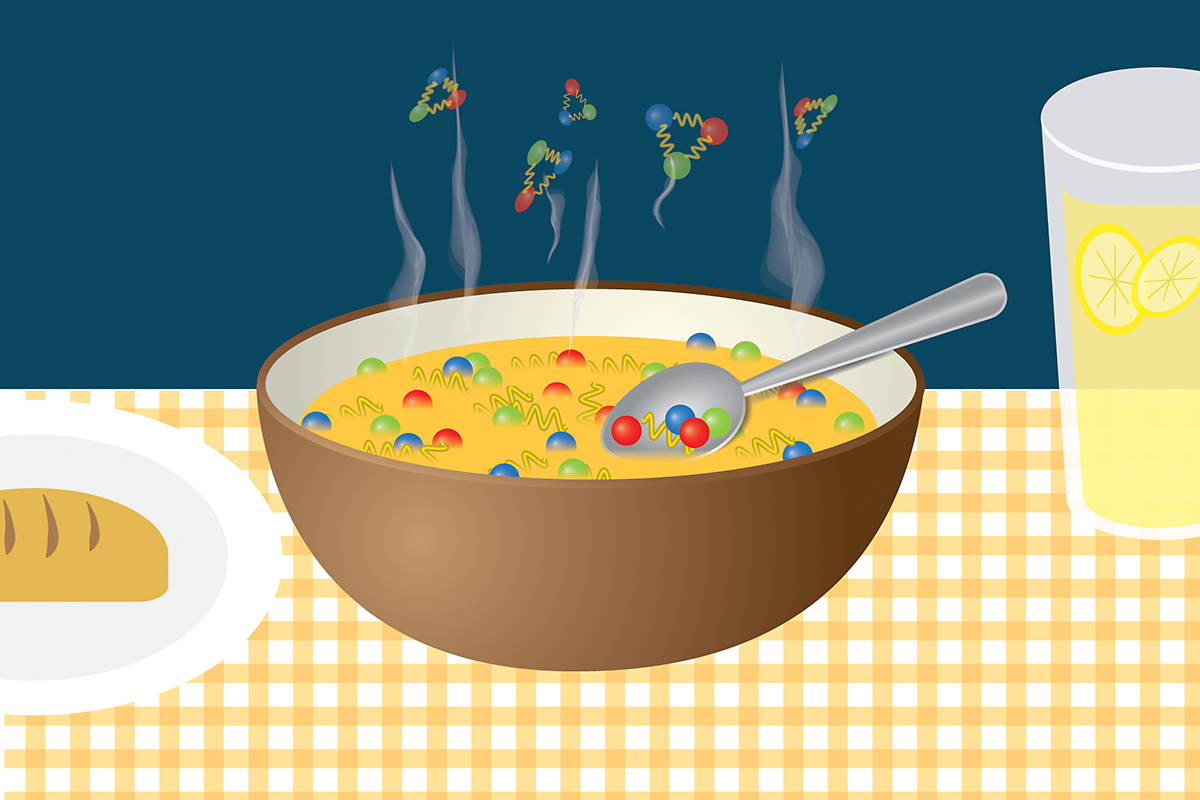
Cold Fusion As Easy As Duck Soup… if ingredients say ‘quark’ instead of ‘quack’.
The earliest published reference to “duck soup,” meaning something that’s a cinch, was in 1902.

Quark Soup is universally nourishing and from it every nuclei is possible. Do I detect a hint of helium, or perhaps some zesty tritium, oh my there are some much heavier taste sensations as well….
Martin Fleischmann who lived out his life on Duck Street knew very well, after an acclaimed lifetime of science, that it was a cinch to make cold quark soup. Some might complain that his soup was a bit dense but that was the beauty of it.
Quark soup is a phase of matter within the context of quantum chromodynamics (QCD) which is hypothesized to exist at extremely high temperature, density, or both temperature and density. This phase of stuff (matter?) is thought to consist of asymptotically free quarks and gluons, which are the basic building blocks of matter. It is believed to have been the primordial soup from which this universe originally congealed.
There is an alternative view of the atomic nucleus wherein nucleons exist within a ‘bag of quarks’ inside the bounds of an atomic nucleus. The common assemblages of quarks into protons and neutrons appear only when one shakes something out of the bag.
Think of an atomic nucleus as an order of quark soup to go, in a bag as it were.

Hydrogen readily enters into palladium and in fact there can be upwards of 1000 times more hydrogen inside a bit of palladium as there is palladium! Click to read more…
Martin’s forte was ultra density and by following his recipes the hydrogen broth achieves a density far in excess of metallic hydrogen and indeed may reach the density of hydrogen quark soup that is thought to exist in the center of some stars. Add some extra condiments such as the intermingling higher Z lattice nuclei and Fleischmann’s quark soup special begins to delight ones palate with any number of new flavours.
So what is Quark Soup really?
If you are interested in atom-ecology you have to become interested in the myriad species that make up that ecology. The discovery of the many sub-atomic particles led Nobel physicist Wolfgang Pauli to exclaim in response to a question of how he managed to remember the complex ecology of atoms by saying, “Had I foreseen that, I would have gone into botany,” later Enrico Fermi paraphrased Pauli to advise his student Leon Lederman: “Young man, if I could remember the names of these particles, I would have been a botanist.”
OK guys I admit I am a botanist/plant ecologist and an atom ecologist, it’s not all that difficult to merge the two disciplines and talk about Atom Ecology. You’ve just got to think like an ecologist who knows he is studying a system so complex it’s true nature is likely never to be entirely or even well defined.
Today while physicists who work with incredible colliders they insist on always using the semantics of high energy/temperature collisions to make and talk about their ‘quark soup.’ They acknowledged that density is also a clear pathway to the primordial brew. For them it’s never so easy as duck soup but if you’ve got the multi-billion dollar machine it works.
In the world of high energy collisions everything takes place in the tiniest instants of time that is the nature of crashing particles together that are travelling at speed nearing the speed of light. A result of this big bang level of high energy cooking is the ever present penetrating aromas, emissions, that are all the scientist ever glimpses.

Scientists have known for years that at the superhot temps of the early universe, matter is able to move in and out of its particle-soup state smoothly, without a clear dividing line between the phases. Once the nuclear physicists on the STAR experiment at the Brookhaven Relativistic Heavy Ion Collider dialed down the temperature and cranked up the density, they observed a telltale sign of a transition more like water turning to ice—with two distinct phases with a clear dividing line between. They announced this result in a paper to be published in Physical Review Letters.
But those whose recipes in atom ecology lean away from instantaneous cooking at incredible expense and more toward the ‘sous vide’ style of cooking where ingredients are ever so slowly contained, compressed, and slow cooked they are following a low cost road that is far less travelled. It should not be a surprise that the two quark soups that result from very different chefs following very different paths ought to end up distinctly different.
Cold Quark Soup With ‘Croutons’/Solitons
In the cold fusion ‘sous vide’ world that Fleischmann wrote the cookbook for the quintessential ingredients are travelling at quite the opposite in terms of speed where because of the super high density they experience and are creating are travelling at speeds/temperatures no greater than the speed of sound. In this atom environment the ecology is one that is characterized by the slowness of everything, a snail like pace at best. In this contained and compressed slow motion world one sees results only as the dish is served.
Many years ago when my own Palo Alto garage experiments in atom ecology, aka cold fusion, were producing some challenging results I went to my friend Dick Taylor at Stanford. I was seeking some means to accommodate and explain the observed production of selected isotopes.
When I told him I wanted his opinion on these cold fusion results Dick who was always good for a quip said, “I’ll tell you what I think Russ, its all bullshit… but that’s a religious conviction of course… now show me that data.”
Out of his consummate experience, and he won the Nobel Prize for that experience in defining the Quark, he said what I had best pointed toward a bag model for the atom…cold quark soup. Conventional physics explanations could not explain the observations.
The problem that cold fusion faces is of course the fact that very very few physicists have the characteristics of Dick Taylor and Martin Fleischmann. They were able to be comfortable in complex ecologies that they did not understand. New mysteries around every turn excited and drove them forward. Whereas for the vast majority of the environment of physics and especially high energy and nuclear physics the detection of high energy emissions has so long been so distinct that the lack of such a signature is taken not as reason for greater curiosity but rather an opportunity for skeptical semantic attack.
Exchange and mixing of quarks and gluons by infusion
Just as the constituents of a good ‘sous vide’ are infused and mixed under compression and at low temperature the sub-atomic ingredients of atoms are participating both in whole and in part in the atom ecology where cold fusion provides for an infusion. Whether it is a deuteron getting together with another deuteron to make an alpha particle or a proton suddenly behaving like a conducting electron here and there at the same time the ‘quark soup’ description of how this bag of quarks and gluons behaves is an apt one.
This requires a fair bit of open minded thinking and an avoidance of the concept known as the law of the instrument, Maslow’s hammer, which is an over-reliance on a familiar tool; as Abraham Maslow said in 1966, “I suppose it is tempting, if the only tool you have is a hammer, to treat everything as if it were a nail.”
Surely the dogma of “conventional” physics demands, Maslow style adherence, that being only the hammer’s point of view is allowed. If one keeps avoidance of that principal in mind by supplementing, where possible, high temperature hammering to include Fleischmann’s extraordinary density then the following video on Quark Soup offers some easy insights.
BNL’s Hot Quark Soup vs. Fleischmann’s Cold Quark Soup
In cold fusion the results of the analysis of the remains has clearly shown an array of strange infusions… tritium, 3He, 4He, anomalous isotope ratios in Li, Cs, Pr, Ti, Ni, Pd, Ag and more. Add to this list some strange ‘neutrons,’ a few fleeting ephemeral x-rays, and perhaps some stray gammas. What is clear is that cold quark soup is somewhat different than the similarly named hot offering found when one cooks the quarks together in impossibly low density hotter than a star temperatures found in super colliders and has but 10-23 of a second to taste and analyze the resulting broth.
As always in cooking ‘too many cooks can spoil the broth’ so when replicating Martin’s recipe variations are welcome so long as too many cooks aren’t insisting on their ideas. Stay tuned as I’ll be recreating and reviewing a few pots of Martin’s best recipes in the new year in a new cold fusion cooking show.
Want to buy a bag to hold your quarks, a ‘quark bag’, there’s a catalog store for that.